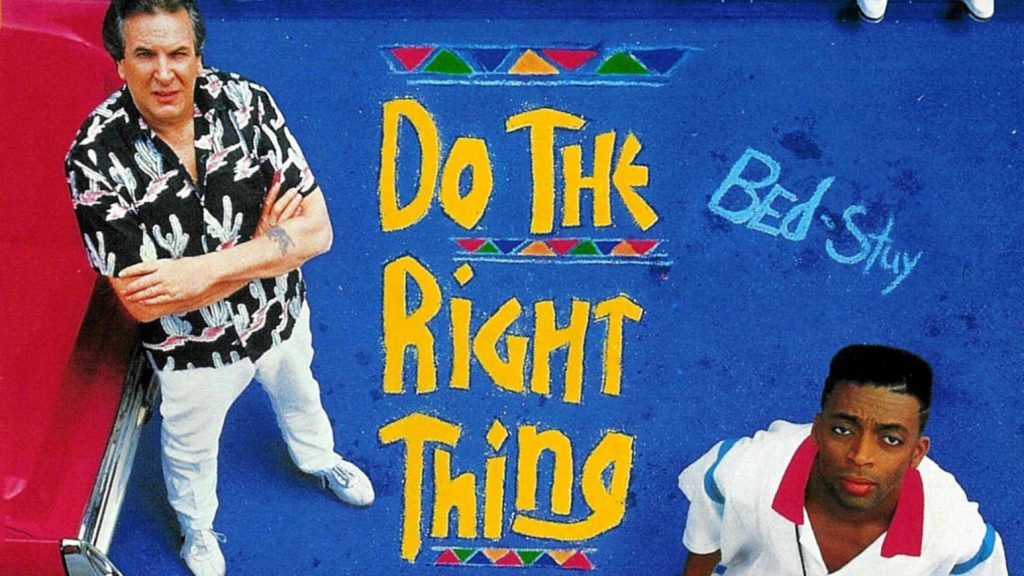For the penultimate screening of our Black History Month Film Series we will be showing one of Spike Lee’s earlier films, a Brooklyn masterpiece that catapulted its director into the spotlight. Lee’s 1989 comedy-drama classic Do The Right Thing will be screened on Monday, Februrary 25 at 7 p.m. in Winona State’s Science Laboratory Center 120 auditorium. The film is rated R for nudity, strong language, violence and adult situations; the event is free and open to the public.
Produced, written and directed by Lee, Do The Right Thing was one of the most controversial and talked about films of the late 1980s. Set in Bedford-Stuyvesant, Brooklyn, Do The Right Thing tells the story of a neighborhood filled with bigotry and racial tension that comes to a boiling point on one of the hottest days of the year. More specifically, it focuses on an family-owned Italian pizzeria that struggles to keep the peace with its customers.

Danny Aiello (left) and Spike Lee star as Sal and Mookie, respectively, in Lee’s Do the Right Thing.
Along with Spike Lee himself, the film stars Danny Aiello, Ossie Davis, Giancarlo Esposito, Samuel L. Jackson, Martin Lawrence and Rosie Perez. Do The Right Thing was a huge commercial success, grossing nearly $40 million on a $6 million budget. It was nominated for two Academy Awards for Best Original Screenplay and Best Supporting Actor and has won or been nominated for numerous other awards in several different categories. In retrospect, many feel the Academy overlooked the film for the Best Picture category, especially in a year when the tame Driving Miss Daisy, which relegated blacks to familiar subordinate roles in a feel-good crowd-pleaser, won Best Picture. Just ten years after its release, Do The Right Thing was deemed “culturally, historically, and aesthetically significant” by the Library of Congress for its National Film Registry. While this Spike Lee film did spark a great deal of controversy, Do The Right Thing called to attention the racial divide in America. It also simultaneously established an unprecedented style of cinema that reflected and influenced the culture of the late 1980s and beyond.

Racial tensions brew on the hottest day of the summer in Do The Right Thing.
After its initial release, Do The Right Thing was generally well received. However, some felt as though the film did not bring to light racial tension as much as it fomented it. Film critic Roger Ebert described the film as “the most honest, complex and unblinking film I have ever seen about the subject of racism.” While Ebert praised the film for these aspects, others got the wrong impression. Lee’s film was met with protests and criticism, saying the film was inciting violence and black audiences may be inspired to start a riot. In a June 26, 1989 issue of New York Magazine, film critic David Denby said “the end of the movie is a shambles, and if some audiences go wild [Lee’s] partly responsible.” In response, Lee asked why white reviewers would assume black audiences were incapable of restraining themselves after seeing a fictional motion picture. Regardless of the controversy it sparked, Do The Right Thing is largely considered one of the great films of the 1980s and one of Spike Lee’s most powerful films in his filmography.

Lee’s canted (Dutch) and extreme angles ratchet up the heat in Sal’s Famous Pizzeria.
Much of Do The Right Thing’s popularity and influence can be attributed to its overall style. Lee’s expansive yet intimate vision is brought to life with the combination of Ernest Dickerson’s cinematography and Ruth E. Carter’s vibrant costume design, both whom Spike Lee has collaborated with several times. Considering the film is set in Brooklyn on the hottest day of the year, “warm” colors are prevalent throughout the film in its costume design, set design, and overall mise-en-scene. Yellows, reds, oranges, ambers, and earth tones result in the audience almost feeling the heat along with the characters on screen. It also reinforces the anxiety and tension that builds up to an inevitable altercation towards the end of the film. Furthermore, the use of Dutch, low- and high-angle shots, and a now-famous breaking of the fourth wall make the film even more raw and nerve-wracking.

Lee and cinematographer Ernest Dickerson employ an intense color scheme that raises the temperature in the Bed-Stuy neighborhood where Do the Right Thing is set.
The late 1980’s costume design is bright, vibrant and Afro-centric. This explosion of color is largely youthful. If you look at some of the older characters in the film, as well as the white characters, in comparison to the young, African-American characters, you can see a clash of styles. The costumes of the youth in Do The Right Thing are expressively loud. On the other hand, the colors worn by most everyone else are muted, their style more reserved. Dressing the African-American youth in loud, vibrant, contrasting colors speaks to the embracing of Afro-centric identity. You can see this same urban Afro-centric style in The Fresh Prince of Bel-Air, or the 1992 film White Men Can’t Jump, just to name a few.
Do The Right Thing is a film that explores racial tension that was brewing in the 1980s and in many ways is still alive today, three decades after its release. The film is extremely prescient in the sense that the racism, the unnecessary death of countless black men at the hands of law enforcement, and the unjust treatment of and attitude towards minorities are all issues confronting Americans today. Its use of Public Enemy’s “Fight the Power” and the closing quotations from Malcolm X and Martin Luther King, Jr invoke Black power and history. Therefore we cordially invite you to join us and celebrate Black History Month by watching one of the strongest films in Spike Lee’s oeuvre, Do The Right Thing.



Trackbacks/Pingbacks